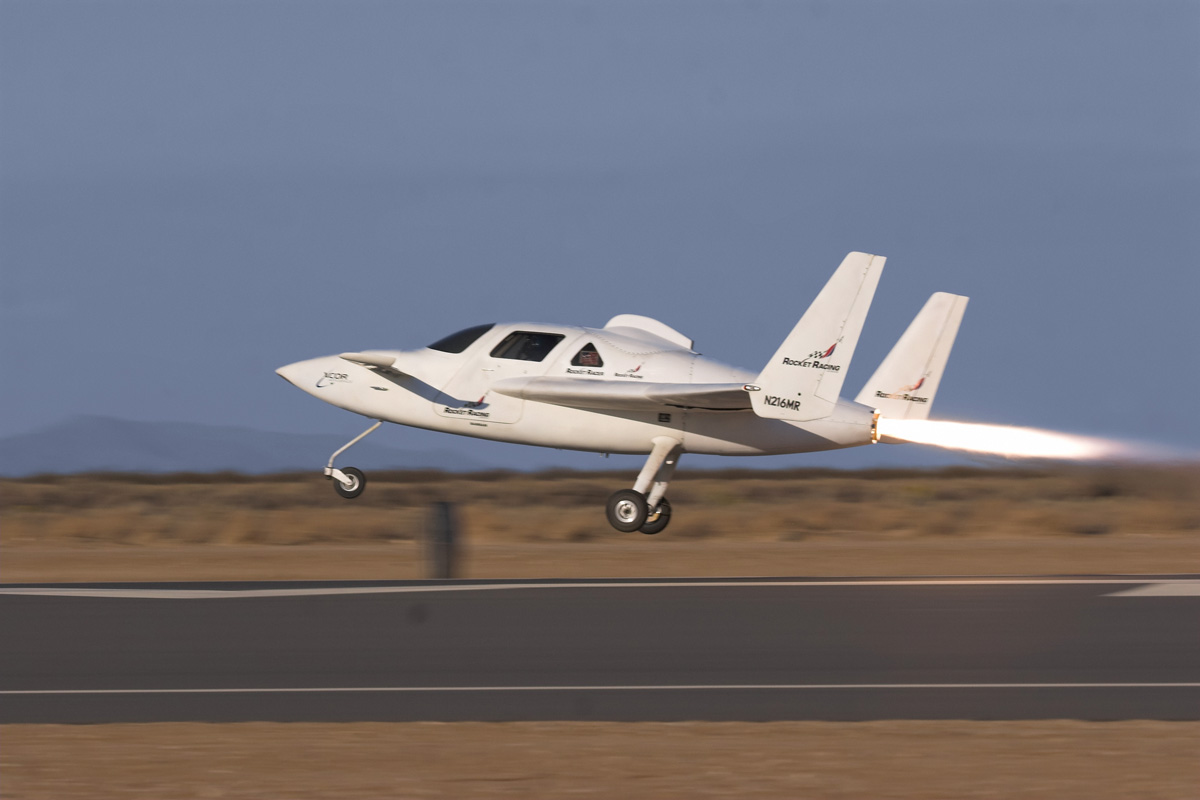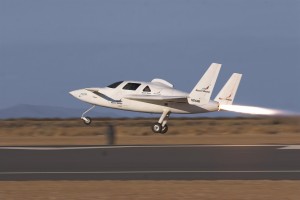
The prototype Rocket Racer takes off for a test flight from the Mojave Desert in October 2007. The rocket produces a 10- to 15-foot long, bright yellow flame and a roar heard and felt for miles.
By Henry M. Holden
The Rocket Racing League of Las Cruces, N.M., combines the competition of air racing with rocketry. X-Prize founder Dr. Peter H. Diamandis, who serves as co-founder and chairman, and Granger B. Whitelaw, a two-time Indianapolis 500 champion team partner who serves as co-founder, president and CEO, established the RRL in 2005.
The Rocket Racing League will use a rocket-powered Velocity, a four-seat pusher canard experimental aircraft. The Rocket Racer, currently under development, began test flights in the fall of 2007. The aircraft will use a single 1,500 to 2,000 pound thrust liquid oxygen and kerosene rocket engine that emits a 10- to 15-foot long, bright yellow flame and a roar heard for miles. Mesquite, Texas-based Armadillo Aerospace will provide the LOX engines.
With the acquisition of Velocity Aircraft by Rocket Racing Composites Corp., a subsidiary of RRL, Velocity will produce an airframe that will be consistent for all competing Rocket Racers.
“The first aircraft we tried was the Long EZ, but we retired the precursor vehicle called the EZ-Rocket,” said Whitelaw. “The EZ-Rocket used a modified Long-EZ aircraft frame and two 400-pound liquid oxygen and alcohol engines. We thought the Velocity was the most stable aircraft for racing that we could make modifications to and add our rocket engines and avionics. It’s an easily crafted composite aircraft, and we liked its flight profile.
“People have contacted us from the very first day asking if they could enter their aircraft into the league. We’ve been saying that after the first two or three years, we’ll announce new engine manufacturers. We’ll certainly look at other aircraft as we get the racing series going and we have some safe vehicles we can add to the mix.”
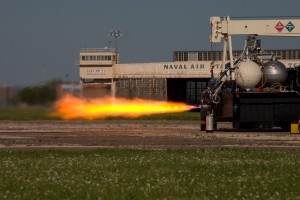
The Rocket Racing League plans to use the Armadillo Aerospace engine, seen here during a test firing. The combination of liquid oxygen and kerosene produces multi-colored exhaust flames.
The Velocity airframe needed major modifications.
“We had to build a new aft section to mount the rocket engine and the LOX tank,” said Whitelaw. “We had to increase its size to hold the larger tank. We made some other structural changes, such as changing the rod system for the ailerons and rudder. We also added some cameras and radios for tracking and viewing. From the wings forward we made very few modifications.”
Safety measures and methodology borrowed from the Formula One and Indy cars will help provide a safer vehicle and better protect pilots and passengers. Reinforced cockpit seats will enable the Rocket Racers to withstand impacts up to a 20 G-load.
Rocket racers will debut at the world’s largest air show.
“We’re going to our first exhibition race at EAA AirVenture, in Oshkosh, Wis., Aug. 1 and 2,” said Whitelaw. “The first flight will be on Tues., July 29, for a press conference, and then on Friday and Saturday for the show. We’ll field one or two aircraft, depending on which aircraft we feel are safe and reliable at the time, to fly in front of the public. The Rocket Racers will have speeds up to 350 miles per hour, and we hope that for the first time, two Rocket Racers will compete head-to-head in a demonstration race on the raceway in the sky.”
He said they might add two or three more at future exhibition races.
“We’re doing it as much for us and for the FAA, to get a feel for what we want to do, and what kinds of modifications we may need to make,” he said. “We’ll be adding other things to the show, and by the end of 2009, we may start the flight series with eight to 10 aircraft racing at one time, and put on a good show with patterns that are safe to fly. It’ll be its own venue and a race, similar to NASCAR racing, with prize money. We’re going to do exhibitions first to let the people see what it looks and feels like. At the end of the day, we want people to have a new experience as well as a fun air show.”
He said the first exhibition race would be an important milestone in the progression of the Rocket Racing League.
“We’re looking forward to sharing the experience and thrill of rocket racing with the public,” he said.
Raceway in the sky
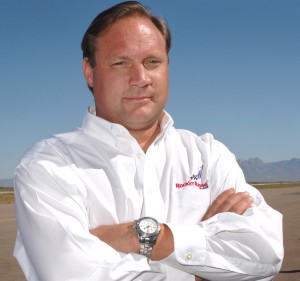
Granger Whitelaw, CEO and co-founder of the Rocket Racing League, oversees the league’s management, operations, partnerships and corporate affairs.
Instead of racing high performance cars around a ground track, the RRL will fly manned rocket-powered airplanes within a virtual three-dimensional track in the sky. The track is one mile high, two miles long and one-half-mile wide. Virtual GPS “tunnels” will shape the closed circuit track. The race will consist of four-lap, multiple elimination heats over a five-mile closed circuit Formula One-type raceway. The thousands of fans in attendance will witness the racing action live and displayed on multiple large projection screens. The fans watching on TVs and PCs at home will experience the thrill of the race via unique remote and rocket-mounted cameras that’ll give them the sensation of riding alongside the pilots.
“People will actually see the rocket planes racing on the tracks,” said Whitelaw. “There’ll be special effects for rocket planes that go through a virtual barrier and are penalized, similar to Formula One races. Viewers will have a view from the cockpit unlike anything that’s been done before. The races are projected to be about an hour and a half in length.”
The Rocket Racers will fly at a safe distance from the crowd, will never fly directly towards or away from the crowd and will follow all air show regulations set forth by the FAA.
“Safety is a number one priority with us,” said Whitelaw. “A team of dedicated engineers and scientists with years of experience in the given fields are charged with ensuring safety for all those involved.”
The teams
Currently, the league has six teams: Thunderhawk Rocket Racing, Santa Fe Racing, Bridenstine Rocket Racing, Rocket Star Racing, Team Extreme Rocket Racing and Canada-based Beyond Gravity Rocket Racing. Down the road, Whitelaw expects a maximum of about 14 teams.
“We’re still working out those details,” Whitelaw said. “The teams, pilot and pit crew will probably be about 10 people. If you include all the support staff, there’ll probably be about 30 to 40.”
World-famous aviators, including retired NASA astronaut Rick Searfoss and aerobatic pilots Sean Tucker, Len Fox and Jim Bridenstine will fly the Rocket Racers, capable of accelerating from zero to full-throttle in a split second.
Funding
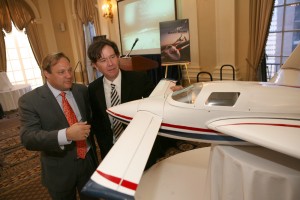
Granger Whitelaw and actor Timothy Hutton examine a scale model of the Velocity Rocket racer. Hutton is a Rocket Racing League advisory board member.
Whitelaw and the board of directors will fund the league privately.
At every Rocket Racing League event, pilots who finish in the top three spots will earn points. The pilot who earns the most points overall at the end of a regular season will be crowned league champion.
“The teams are individually owned, so they’ll have their own funding, whether it’s from private money or sponsors,” said Whitelaw. “The prize monies will all be funded by sponsors. The first prize will be $100,000, with other prizes for fastest turn around, lap, pit stop and so on.”
He said revenues would be generated through six primary sources. Each will fall under a separate revenue unit of the RRL: sponsorship, sanctioning fees (and venue related revenues), merchandising/licensing, broadcast rights, gaming and touring/amusement park offerings. The licensing of intellectual property will generate additional revenues.
“We anticipate our crowds to reach the same level for those who attend other motorsports and air show events—between 100,000 and 500,000 people,” said Whitelaw.
Following the first exhibition race, the RRL will hold exhibition races at Reno National Championship Air Races, in Reno, Nev., X Prize Cup, in Las Cruces, N.M., and Aviation Nation, Nellis AFB, in Las Vegas, Nev.
For more information on the Rocket Racing League, visit [http://www.rocketracingleague.com].











